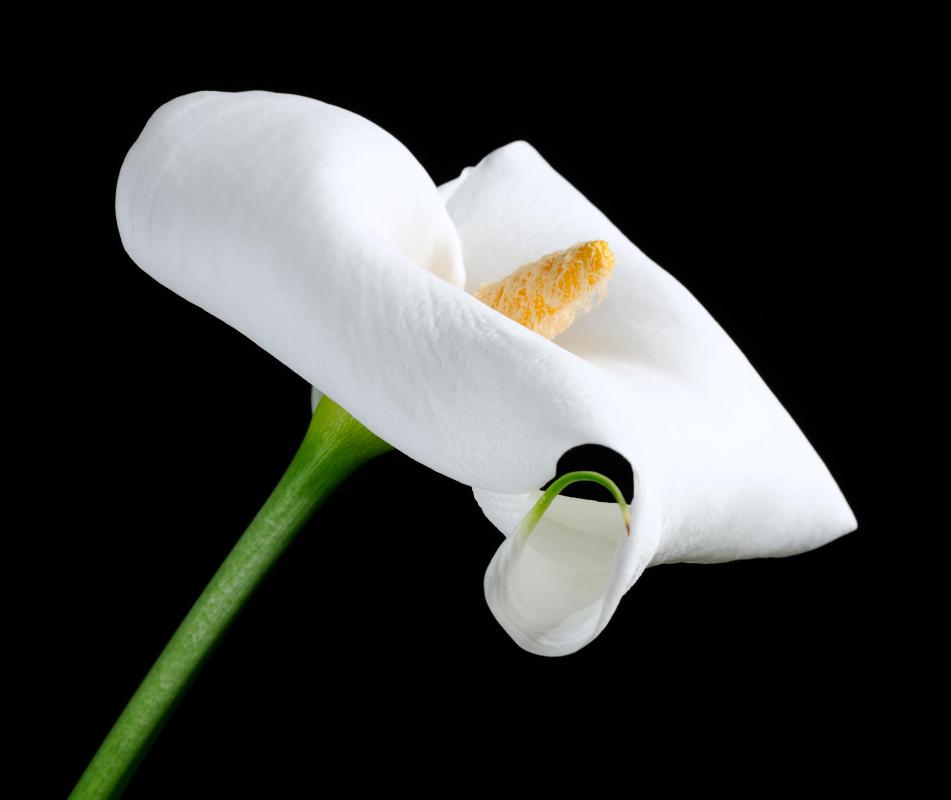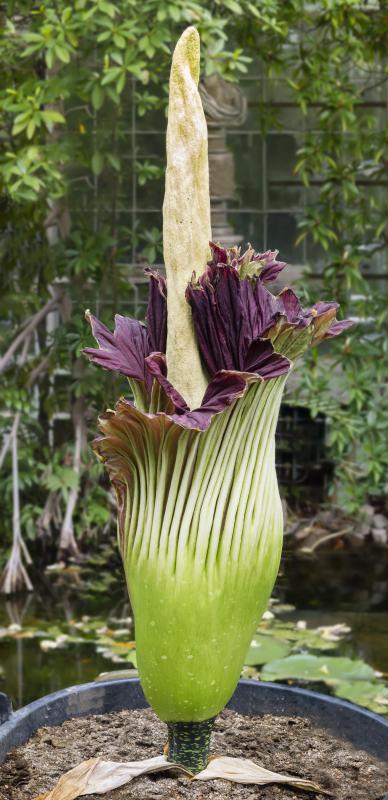At AllThingsNature, we're committed to delivering accurate, trustworthy information. Our expert-authored content is rigorously fact-checked and sourced from credible authorities. Discover how we uphold the highest standards in providing you with reliable knowledge.
What is the Titan Arum?
The titan arum (Amorphophallus titanum) is a plant with the largest flowering structure in the world. Its inflorescence is made up of many tiny flowers on a spadix, surrounded by a spathe, both types of spikes, making it resemble the related calla lily in shape. Titan arum can reach nearly ten feet (3 m) in height. It is native to the Sumatran rainforests in Indonesia but has been cultivated elsewhere. Titan arum was discovered by Italian botanist Odoardo Beccari in 1878.
Titan arum has a hollow spadix ranging from pale yellow to light purple. The upper, visible portion is covered in pollen, while the lower part is covered in bright orange carpels, the female reproductive organ. The spathe is green on the outside and reddish-purple on the inside. Titan arum is one of the plants nicknamed "corpse flower," as it emits a smell of rotting meat to attract its fly and beetle pollinators. The dark red color of the plant also simulates dead flesh, and the tip of the spadix is close to human body temperature when it blooms, further attracting carrion insects.
Male and female flowers bloom in the same inflorescence of the titan arum. Male flowers bloom a day or two after female flowers to prevent self-pollination. After blooming, the flowering structure wilts and dies within a few days.

A single huge, umbrella-like leaf sprouts from the plant's root after the flower has died. It can reach up to 20 feet (6 m) in height, with a 16 foot (5 m) span. The leaves of titan arum plants in captivity only grow to about 12 feet (3.6 m). The leaf is replaced every year until the plant has stored enough energy to bloom again. At that point, the plant becomes dormant for four months before blooming again.
Titan arum plants were first cultivated in captivity in the Royal Botanic Gardens at Kew in London, in 1889. Since then about 100 plants have been cultivated, including some in the United States and Germany.
Frequently Asked Questions
What is the Titan Arum and why is it unique?

The Titan Arum, also known as the corpse flower, is a rare and striking plant native to the rainforests of Sumatra. It is unique for its massive flowering structure, the inflorescence, which can reach over 10 feet in height and emit a strong odor reminiscent of decaying flesh. This scent attracts pollinators like carrion beetles and flesh flies.
How often does the Titan Arum bloom and for how long?
The blooming of a Titan Arum is a rare event that occurs roughly every 7 to 10 years, and the flower remains open for just 24 to 48 hours. During this brief window, the plant releases its pungent odor to attract pollinators, a critical phase for its reproduction. The rarity of its bloom makes it a spectacle in botanical gardens worldwide.
What is the purpose of the Titan Arum's strong odor?
The Titan Arum's strong odor serves a vital purpose in its reproduction. The smell mimics that of rotting meat, which is irresistible to certain pollinators such as carrion beetles and flesh flies. These insects are tricked into thinking the flower is a food source, and as they search for a meal, they inadvertently collect and transfer pollen, facilitating the plant's fertilization process.
How large can a Titan Arum get?
A Titan Arum can grow to monumental proportions, with its inflorescence reaching over 10 feet in height and its single leaf growing up to 20 feet tall and 15 feet across. Its corm, a tuber-like storage organ, can weigh as much as 200 pounds, making it one of the largest flowering structures and corms in the plant kingdom.
Is the Titan Arum endangered?
According to the International Union for Conservation of Nature (IUCN), the Titan Arum is classified as Vulnerable. Its survival is threatened by habitat loss due to deforestation and land conversion in its native Sumatra. Conservation efforts are crucial to protect this species and its unique ecological niche in the rainforest ecosystem.
Can the Titan Arum be grown outside its natural habitat?
Yes, the Titan Arum can be grown outside its natural habitat, and it is often cultivated in botanical gardens around the world. However, replicating its native tropical conditions is challenging, requiring high humidity, warm temperatures, and careful soil management. Despite these challenges, successful bloomings in cultivation have made the Titan Arum accessible to a broader audience, raising awareness of its conservation needs.
AS FEATURED ON:
AS FEATURED ON:












Discuss this Article
Post your comments